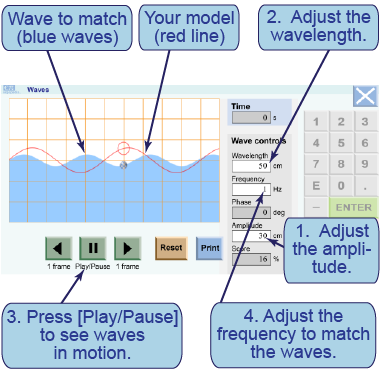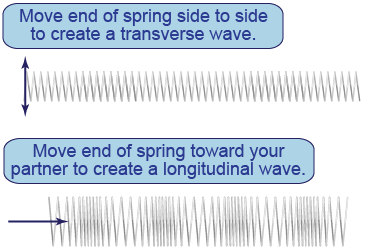| | Essential questions | | What is a wave and what are the properties of waves? | |
|
A wave is a traveling form of energy that carries oscillations from one place in space to another. Sound and light are both waves and share characteristics of frequency and wavelength with familiar water waves. This investigation will use a simulation of water waves to characterize the properties of frequency, amplitude, and wavelength. 
|
Part 1: Match a wave’s properties

- Open the interactive simulation. You will create a mathematical model of a wave (red line) to match the blue waves representing water.
- Adjust the amplitude and wavelength to match the blue wave.
- Run and Pause the waves. Adjust the frequency until the red circle bobbing in your model matches the bobbing of the floating ball.
- Describe how changing the amplitude changes the wave.
- Describe the effect of changing the wavelength.
- Describe the effect of changing the frequency.
- What are the frequency, amplitude, and wavelength of the blue wave?
- Draw a graph showing the amplitude and wavelength of this wave.
- Calculate the speed of the wave. Show your work.

|
This simulation allows you to overlay a mathematical wave (red line) on a moving water wave (filled blue). When you match the amplitude, frequency, wavelength, and phase of the water wave, your calculated wave will move with the real wave—and the red circle floating on top of your model wave will match the motion of the checkered ball floating on top of the blue water wave.
|
Part 2: Transverse and longitudinal waves

- Hold one end of a Slinky® spring (or other long spring) and have your partner hold the other end. Stretch the spring a little bit so that it is not slack.
- Create transverse waves by moving your hand side to side.
- Create longitudinal waves by moving your hand sharply toward your partner.
- Repeat the above steps, but this time using a wave motion rope or other heavy string.
- What are the differences between these two types of waves? Describe the characteristics of each in words.
- Can you make both types of waves on both pieces of equipment? Why or why not?
- Can you create waves of different velocities with the spring or rope? If so, how?

| |
| |
|

